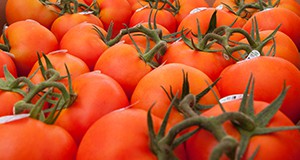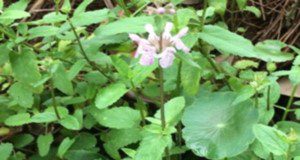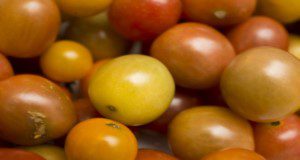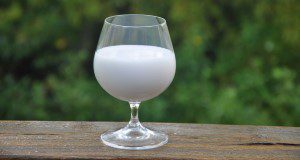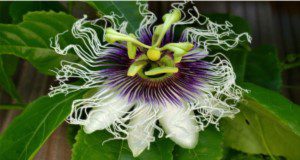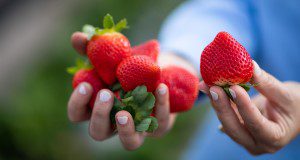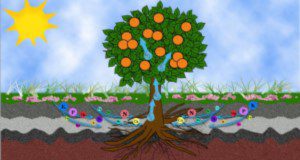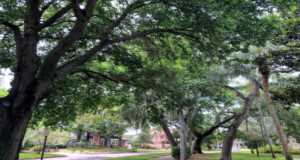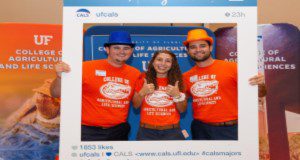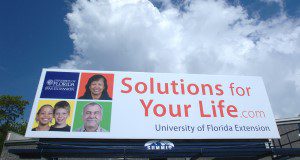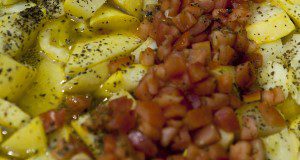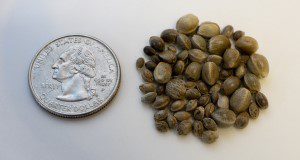Tobamoviruses are mechanically transmitted plant viruses that cause severe economic damage to vegetable and ornamental crops in Florida and worldwide. While certain tomato cultivars have genetic resistance to the most common tobamoviruses, no commercial tomato cultivars are resistant to tomato brown rugose fruit virus (ToBRFV), a recently described tobamovirus that also infects pepper and eggplant. It is currently unknown how ToBRFV may affect tomato production in Florida. This new 5-page publication of the UF/IFAS Plant Pathology Department describes symptoms of the virus, how it is different from other tobamoviruses, and how it is transmitted, as well as what to do if you think you have ToBRFV in your field. Written by Ozgur Batuman, Salih Yilmaz, Pamela Roberts, Eugene McAvoy, Samuel Hutton, Kishore Dey, and Scott Adkins.
https://edis.ifas.ufl.edu/pp360
Author: Paul Roberts
Biology and Management of Florida Betony (Stachys floridana) in Ornamental Plants in Landscape Planting Beds
Florida betony (Stachys floridana) is a perennial weed in Florida landscape planting beds, gardens, turfgrass, and agricultural production systems. This new 4-page article is written for green industry professionals and others to aid in the identification and management of Florida betony in and around ornamental plants in landscape planting beds. Written by Thomas Smith and Chris Marble, and published by the UF/IFAS Environmental Horticulture Department.
https://edis.ifas.ufl.edu/ep597
Herbicide Resistance Management in Florida Tomato Production
Herbicide resistance was historically not a significant issue in most horticultural crops because few herbicides were applied. Close proximity of agronomic crops and the loss of methyl bromide has led to a gradual increase in herbicide inputs and the increased occurrence of herbicide-resistant weeds in tomato fields. Very few herbicides are registered for tomato, and resistance is a major concern. This new 11-page publication of the UF/IFAS Horticultural Sciences Department provides a definition of herbicide resistance, explains how it develops, and provides management recommendations for tomato growers. It was written for growers and Extension agents, but the information may be of interest to anyone concerned about herbicide resistance in vegetable and small fruit crops. Written by Shaun M. Sharpe, Nathan S. Boyd, Ramdas G. Kanissery, and Peter J. Dittmar.
https://edis.ifas.ufl.edu/hs1398
Leches a base de plantas: Coco
La leche de coco es una de las muchas variedades de alternativas vegetales a la leche de vaca. Los factores que pueden llevar a los consumidores hacia alternativas a la leche no láctea incluyen la adherencia a una dieta vegana, la intolerancia a la lactosa, la alergia a la leche de vaca o simplemente la preferencia. El propósito de esta guía es informarle sobre el contenido de nutrientes de la leche de coco y sus posibles beneficios y riesgos para la salud.
This new 4-page article is the Spanish language version of FSHN20-49/FS411, Plant-Based Milks: Coconut, written by Celia Andreo, Daniela Rivero-Mendoza, and Wendy J Dahl, and published by the UF/IFAS Food Science and Human Nutrition Department.
https://edis.ifas.ufl.edu/fs421
The Road to Recovery: Building Physical and Emotional Trust when Engaging with Extension Clientele
Now is a crucial time for Extension professionals to engage with clientele. In both urban and rural communities, clients are facing a multitude of unprecedented challenges related to COVID-19. Many Extension professionals already have experience in emergency and disaster preparedness, response, and recovery that can be applied in the present context. However, we must rethink how we interact with and assist clientele to ensure their safety and our own. To do this, it is critical we understand that the pandemic has exacerbated emotional trauma and anxiety resulting in trust gaps. This new 4-page publication of the UF/IFAS Department of Agricultural Education and Communication aims to build Extension professionals’ sensitivity to the needs and emotional strains that COVID-19 presents for clients, and the strategies needed for effective recovery. Written by Colby Silvert, Cody Gusto, and John Diaz.
https://edis.ifas.ufl.edu/wc376
Passion Fruit Problems in the Home Landscape
In Florida, purple and yellow passion fruit have been widely cultivated by homeowners for years, and south Florida’s subtropical climate allows for growing passion fruit year-round. Many factors affect longevity and productivity of passion fruit vine, including environmental stresses, pests, and disease. This new 5-page document is designed to help Master Gardeners and homeowners by answering commonly asked questions about passion fruit production problems. Written by Amir Rezazadeh, Mark Bailey, and Ali Sarkhosh, and published by the UF/IFAS Horticultural Sciences Department.
https://edis.ifas.ufl.edu/hs1397
Leaf Spot Diseases of Strawberry
Several different fungi and one bacterium cause leaf spot diseases of Florida strawberry. Symptoms caused by these pathogens are often similar, leading to confusion and misdiagnosis of the disease. To facilitate diagnosis, the most common leaf spots diseases of strawberry in Florida are described in this new 6-page article, written by Juliana S. Baggio, James C. Mertely, and Natalia A. Peres, and published by the UF/IFAS Plant Pathology Department.
https://edis.ifas.ufl.edu/pp359
The Pear (Pyrus spp.) in Florida Home Gardens
Pears are a great tree to grow for an edible landscape or fruit garden. However, pears are not adapted to all areas in Florida, and only a few cultivated varieties will grow well here. An adaptation to warm winters (low chill hours) and disease resistance are the main factors for success. This new 6-page publication of the UF/IFAS Horticultural Sciences Department provides information to help homeowners select and grow pears successfully in Florida. Written by Juanita Popenoe, Ali Sarkhosh, and Dustin Huff.
https://edis.ifas.ufl.edu/hs1393
A Simple, Inexpensive, and Portable Image-Based Technique for Nondestructive Leaf Area Measurements
This new 6-page article, part of a series introducing various image-based measurements for horticultural research, introduces a simple, inexpensive, and portable image-based technique for nondestructive leaf area measurements. It uses an imaging apparatus made with ordinary office supplies to obtain leaf images in greenhouse or field environments. Leaf images are then processed and analyzed to measure leaf area using ImageJ, an open-source image processing program. Because both image capture and analysis are performed nondestructively, leaf area can be measured on the same leaf repeatedly, enabling the monitoring of leaf growth over time, as well as photosynthesis and transpiration. This technique is particularly useful to researchers and students studying leaf growth and physiology in greenhouse or field environments. Written by Shinsuke Agehara, Lillian Pride, Mariel Gallardo, and Jose Hernandez-Monterroza, and published by the UF/IFAS Horticultural Sciences Department.
https://edis.ifas.ufl.edu/hs1395
Planning for a Successful Commercial Subtropical/Tropical Fruit Grove
Planning is the key to successful grove establishment, maintenance, and production. Developing a detailed infrastructure description and plan, cultural program, and financial and marketing plan for a new or existing grove with a new fruit crop will save you time and money and help minimize mistakes. Prospective growers should compile and analyze information needed to select a grove site, establish the needed infrastructure, and develop maintenance plans for the plants and how the production will be marketed. This new 15-page publication of the UF/IFAS Horticultural Sciences Department presents an outline of the type of information growers need when establishing a tropical fruit grove or contemplating management or modification of an existing grove. Written by Jonathan Crane, Yuncong Li, Edward Evans, Fredy Ballen, and Jeff Wasielewski.
https://edis.ifas.ufl.edu/hs1387
Métodos para el establecimiento de trasplantes de fresa en Florida
Florida es el segundo productor de fresa más grade de los Estados Unidos, con un valor estimado de $337 millones. La siembra inicia entre finales de septiembre y mediados de octubre, en momentos donde las altas temperaturas representan un reto significativo para la sobrevivencia de los trasplantes, y por tanto también para el rendimiento y la calidad. El propósito principal de esta publicación es proporcionar recomendaciones basadas en resultados de investigación sobre métodos de establecimientos de trasplantes para productores de fresas en la Florida.
This new 5-page publication of the UF/IFAS Horticultural Sciences Department is the Spanish translation of HS1376, Methods for Strawberry Transplant Establishment in Florida. Written by Emmanuel Torres-Quezada, Lincoln Zotarelli, Vance M. Whitaker, and Shinsuke Agehara.
https://edis.ifas.ufl.edu/hs1378
Methods for Strawberry Transplant Establishment in Florida
Florida is the second largest strawberry producer in the United States, with an annual farm gate value of about $300 million. Planting occurs from late September through late October, and high air temperatures pose significant challenges for transplant establishment and thus yield and fruit quality. The primary purpose of this new 4-page publication of the UF/IFAS Horticultural Sciences Department is to provide research-based recommendations on transplant establishment methods for strawberry growers in Florida. The techniques presented are overhead irrigation application methods and practices, strawberry plugs and bare-root transplants, crop protectants, and reflective mulching. Written by Emmanuel Torres-Quezada, Lincoln Zotarelli, Vance M. Whitaker, and Shinsuke Agehara.
https://edis.ifas.ufl.edu/hs1376
Movement of Plant Nutrients
This new two-page document discusses soil-applied and foliar fertilization for citrus trees as well as mobile and immobile nutrients and how they affect the choice of fertilization. Written by Tripti Vashisth and Chris Oswalt, and published by the UF/IFAS Horticultural Sciences Department.
https://edis.ifas.ufl.edu/hs1373
Florida’s Urban Forest: A Valuation of Benefits
This new 13-page article combines canopy coverage data from all of Florida’s metropolitan and micropolitan areas with ecological models developed by the USDA Forest Service to calculate several key benefits of urban trees and an approximation of their monetary value. Benefits of urban trees include carbon sequestration/storage, air pollution filtration, and stormwater mitigation. Written by Drew C. McLean, Andrew K. Koeser, Deborah R. Hilbert, Shawn Landry, Amr Abd-Elrahman, Katie Britt, Mary Lusk, Michael G. Andreu, and Robert J. Northrop, and published by the UF/IFAS Environmental Horticulture Department.
https://edis.ifas.ufl.edu/ep595
Using Social Media to Engage Communities with Research: SMART Social Media: Planning for Success
This new 6-page publication of the Department of Agricultural Education and Communication focuses on developing social media plans. The intended audience is individuals (e.g., scientists wishing to share their research), organizations, or people who work on grant-funded research projects. In this article, we provide evidence-based strategies for designing, developing, and implementing social media plans to share science research with others inside and outside of the professional scientific community. While the design, development, and implementation of social media may vary, we provide general strategies that are applicable across contexts. Written by Lisa Lundgren, Kathryn A. Stofer, Kirsten Hecht, and Tyus D. Williams.
https://edis.ifas.ufl.edu/wc362
Using Social Media to Engage Communities with Research: Basics
This new 7-page publication of the Department of Agricultural Education and Communication defines social media, presents reasons for using it to share science, and identifies multiple platforms available for use now. We provide an introduction to and overview for a series on getting the most out of social media for sharing science or STEM, including agricultural research. Our primary goal is to assist people working through social media to broaden the community engaged with research. The series includes additional publications on social media planning, evaluating social media engagement, and social media for branding, among other topics. Written by Kathryn A. Stofer, Lisa Lundgren, Kirsten Hecht, and Tyus D. Williams.
https://edis.ifas.ufl.edu/wc361
Understanding Extension for School-Based Agricultural Education #1: Extension 101
This article and series were designed primarily for use by secondary agriscience teachers in school-based agricultural education programs (SBAE) to help build a strong understanding of Extension and the role of Extension professionals. An important part of access and use of Extension services is understanding its background, structure, and function. This initial publication in the Understanding Extension for School-Based Agricultural Education series provides agricultural educators and the general public with a basic understanding of Extension. This new 4-page publication of the Department of Agricultural Education and Communication was written by Debra Barry, John Diaz, Alyssa Shepherd, Jennifer Patton, and Stephen Gran.
https://edis.ifas.ufl.edu/wc372
Nutricion para la salud y el estado fisico: azucar y otros edulcorantes
Esta publicación proporciona información sobre azúcares y otros edulcorantes en la dieta estadounidense. La publicación describe fuentes ocultas de azúcares agregados en los alimentos para ayudar a aquellos que desean reducir la ingesta de azúcar, a encontrar los azúcares agregados en sus dietas. La sección sobre edulcorantes de alta intensidad analiza las características de cada edulcorante aprobado.
This is the Spanish translation of FSHN20-46/FS406, Nutrition for Health and Fitness: Sugar and Other Sweeteners. Written by Wendy Dahl and Linda Bobroff, translated by Daniela Rivero-Mendoza, and published by the UF/IFAS Food Science and Human Nutrition Department.
https://edis.ifas.ufl.edu/fs407
The Mediterranean Lifestyle: The Power of Food
The Mediterranean diet dates back to the early 1960s, in which the population living among the Mediterranean basin, much of Greece and Southern Italy consumed high amounts of fruits, vegetables, nuts, legumes, and unprocessed cereals with minimal consumption of meat. This dietary pattern has been shown to improve heart health, maintain weight, and reduce the risk for chronic diseases such as cardiovascular disease and type 2 diabetes. This new 6-page publication discusses the Mediterranean dietary pattern and provides tips to incorporate this lifestyle into daily life, as well as sample recipes. Written by Charissa Lim, Alexa Hosey, Farah Tadros, Madison Woodard, and Jeanette Andrade, and published by the UF/IFAS Food Science and Human Nutrition Department.
https://edis.ifas.ufl.edu/fs399
Plant-Based Milks: Hemp
Hemp milk is a plant-based milk growing in popularity. Commercial hemp seed, used in the production of hemp milk, contains only trace amounts of the compound tetrahydrocannabinol (THC), much too low to produce any psychoactive effects from consuming the milk. This new 4-page publication describes the composition of hemp milk and the potential health benefits and risks. Written by Sarah Curl, Daniela Rivero-Mendoza, and Wendy J. Dahl, and published by the UF/IFAS Food Science and Human Nutrition Department.
https://edis.ifas.ufl.edu/fs420
